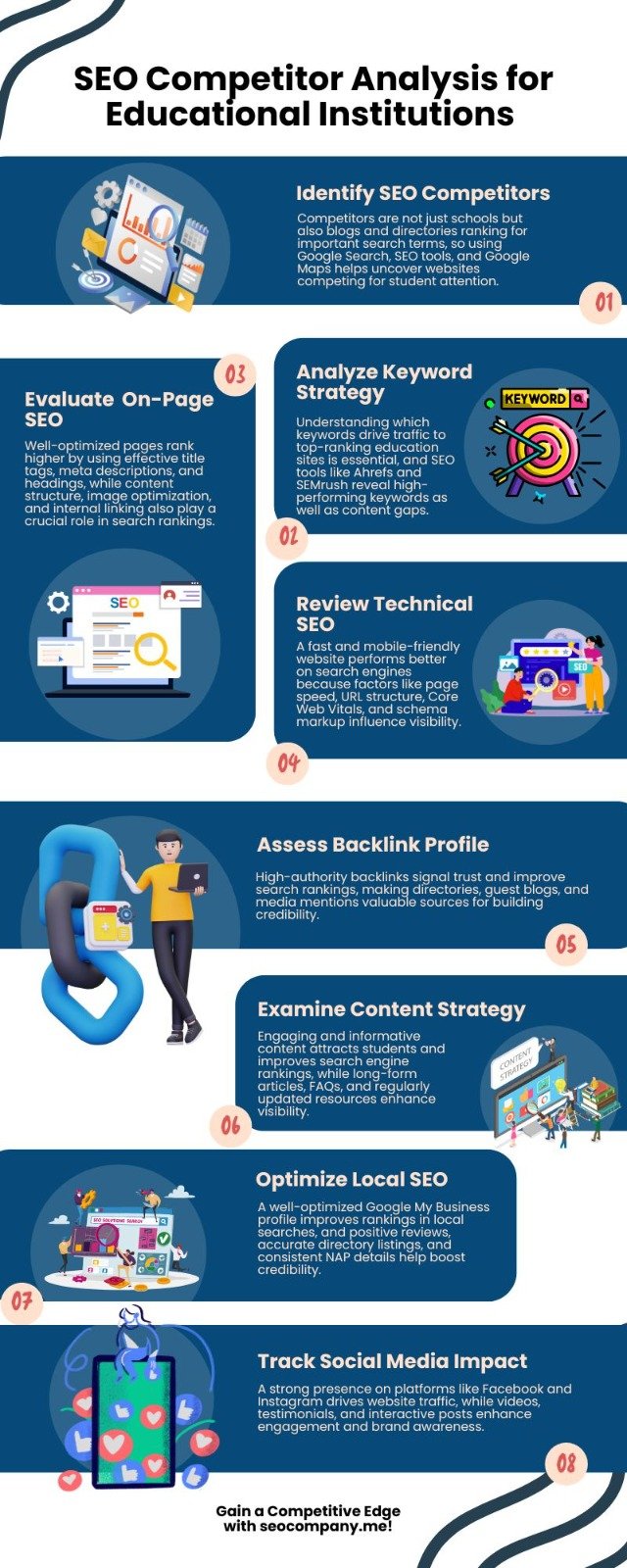In Singapore’s highly competitive education sector, ranking higher on Google is crucial for attracting students. Many educational institutions—whether private schools, tuition centers, universities, or enrichment programs—invest in SEO to improve their online visibility. But how do you ensure that your institution stays ahead of competitors?
The answer lies in SEO competitor analysis. By looking at what other schools do well (and poorly), you can improve your strategy. This will help you get better rankings, more visitors, and more student enrollments.
In this guide, we will show you how to do an SEO competitor analysis for schools.
1. Identify Your SEO Competitors
Your SEO competitors are not only schools that offer similar courses. They also include any website that ranks for your target keywords.
How to Find Your SEO Competitors:
Google Search – Look for phrases like “best international schools in Singapore” or “top PSLE tuition centers.” Take note of the websites that show up in the top results.
SEO Tools – Use tools like SEMrush, Ahrefs, or Moz to find websites ranking for your target keywords.
Google Maps Listings – If your school wants local students, see which competitors are listed in Google Maps and Google My Business (GMB).
Tip: Your biggest competitors might not be who you expect—they could be education blogs, directories, or aggregator sites.
2. Analyse Competitors’ Keyword Strategy
Understanding the keywords that competitors rank for helps you discover high-performing search terms to target.
How to Find Competitors’ Keywords:
Use SEO Tools – Enter a competitor’s website into tools like SEMrush or Ahrefs to see their top-ranking keywords.
Check Their Content – Look at competitors’ blog posts, course pages, and FAQs to identify common keywords.
Identify Gaps – Find keywords they rank for that you don’t and consider creating content around those topics.
Example: If a competitor ranks for “best A-Level tuition Singapore”, but your website doesn’t, you should consider creating optimized content on that topic.
3. Evaluate Their On-Page SEO
On-page SEO refers to how well a competitor’s website is optimized for search engines.
Key On-Page SEO Factors to Analyze:
Title Tags & Meta Descriptions – Do they include target keywords? Are they engaging?
Heading Structure (H1, H2, H3) – Are keywords used in headings for better readability?
Content Quality – Is their content well-structured, informative, and optimised for SEO?
Image Optimisation – Are they using alt text and compressed images for fast loading?
Internal Linking – Do they strategically link to related pages to boost SEO?
Tip: If a competitor ranks higher than you, look at their page structure and content. This may show why Google likes their page more than yours.
4. Analyse Competitors’ Technical SEO
Technical SEO affects how search engines crawl and index a website. If a competitor has a well-optimized site, they may rank higher—even with similar content.
Technical SEO Factors to Analyze:
Website Speed – Use Google PageSpeed Insights to compare loading times.
Mobile-Friendliness – Check if their site is responsive on different devices.
Core Web Vitals – Measure performance, interactivity, and visual stability.
URL Structure – Are their URLs clean, keyword-rich, and properly structured?
Schema Markup – Do they use structured data (e.g., course details, reviews) for rich search results?
Tip: If a competitor’s site loads faster and performs better, Google may rank them higher, even if your content is better.
5. Assess Their Backlink Profile
Backlinks (links from other websites) signal authority and trust to search engines. If your competitors have high-quality backlinks, they are likely to rank higher.
How to Analyze Competitor Backlinks:
Use Ahrefs or Moz – Check how many backlinks they have and where they come from.
Look for Patterns – Are they getting links from education directories, news sites, or guest blogs?
Identify Opportunities – Can you get similar or better backlinks for your site?
Example: If a competitor has links from Singapore education directories, submit your website to those same directories. This can help improve your SEO.
6. Examine Their Content Strategy
Content marketing plays a big role in SEO. If a competitor ranks higher, their content strategy is likely stronger.
Key Content Factors to Analyze:
Types of Content – Do they publish blog posts, case studies, guides, or videos?
Content Length – Are their blog posts longer and more detailed?
Engagement Metrics – Do they get comments, shares, and backlinks to their content?
Content Updates – How frequently do they update old content?
Tip: If a competitor has high-performing content, create better and more in-depth content on similar topics.
7. Review Their Local SEO Strategy
If your institution relies on local students, local SEO is critical. Competitors ranking higher in Google Maps and local search results often have a stronger Google My Business (GMB) strategy.
How to Analyse Local SEO Competitors:
Check Their Google My Business (GMB) Profile – Are they optimising their description, photos, and reviews?
Look at Reviews & Ratings – Do they have more positive reviews than your institution?
Analyse Local Citations – Are they listed in education directories, forums, and news websites?
NAP Consistency – Ensure their Name, Address, and Phone number match across listings.
Tip: If a competitor has better reviews and citations, improve your GMB profile. Encourage more students to leave reviews.
8. Monitor Competitors’ Social Media Presence
While social media does not directly impact SEO, it influences brand awareness and drives traffic.
Social Media Factors to Analyze:
Active Platforms – Are they on Facebook, Instagram, LinkedIn, or TikTok?
Content Type – Do they post videos, articles, student testimonials, or webinars?
Engagement Rates – How many likes, shares, and comments do they get?
Referral Traffic – Do they use social media to drive traffic to their website?
Tip: If a competitor’s social media posts are driving more traffic, improve your social media content strategy.
Gain a Competitive Edge with SEOCompany.me
Doing an SEO competitor analysis is not just about seeing what others do. It’s about using that information to create a successful strategy. By analysing:
- Keyword strategies to target high-ranking search terms
- On-page & technical SEO to improve website performance
- Backlinks & local SEO to increase authority and visibility
- Content & social media strategies to attract and engage students
- Your institution can outperform competitors, rank higher on Google, and boost student enrollment.
At SEOCompany.me, we specialise in SEO for educational institutions in Singapore. We have many years of experience. We have helped schools, tutoring centers, and universities improve their rankings. We also helped them increase their traffic.
Expert SEO Competitor Analysis – We find the strengths and weaknesses of your competitors. This helps us create a custom SEO strategy to improve your ranking.
Data-Driven SEO Execution – Our team implements high-impact SEO techniques to optimise your website for maximum visibility.
Ongoing Performance Tracking – We continuously monitor rankings, backlinks, and content effectiveness to ensure you stay ahead.
Want to dominate Google rankings and attract more students? Contact SEOCompany.me today for a FREE SEO audit, and let’s take your institution to the next level!
Author
-
Eugene Peh is the partner of SEOCompany.me, specializing in business development, marketing strategy, SEO, and digital growth. Passionate about helping companies grow, he employs creativity and innovative marketing solutions to enhance brand awareness and support sustainable execution. His expertise in SEO paid media and performance marketing research & strategies keeps clients ahead in the ever-evolving digital landscape.
View all posts
 Eugene Peh
Eugene Peh




